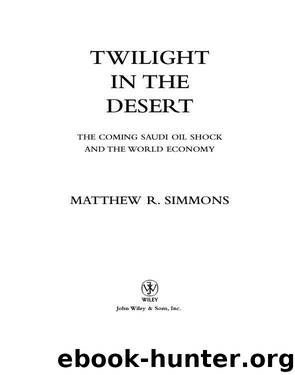Twilight in the Desert by Matthew R. Simmons

Author:Matthew R. Simmons
Language: eng
Format: epub
Publisher: Wiley
Published: 2010-12-27T16:00:00+00:00
9
The Best of the Rest
The Lower-Production Oilfields
The half-century of miraculous oil production in Saudi Arabia has been anchored by the largest oilfield the world has ever known, Ghawar, supported strongly by three other super-giant fields, Safaniya, Abqaiq, and Berri. In 1979, when Saudi Arabia’s oil output was nearing its all-time peak, these four fields accounted for 8.5 million barrels a day of a 9.8 million barrel sustainable peak output. All three of these sustaining oilfields are well past their production peaks and possibly nearing steep production declines. They might be reinvigorated for some period of time through aggressive drilling and stimulation strategies, but this would be the equivalent of performing a tune-up on a 30-year old Buick: It will make the car run better for a short while, but top speed will be 60 miles per hour instead of 95, and every hard acceleration will take a toll. Only with Ghawar is it unclear whether production has peaked or not. But if Ghawar is still capable of producing more than five million barrels per day, everything said about the field in the technical literature suggests that output at such a rate could not be sustained for very long, and it would damage future productivity.
What, then, of the other fields that have supplemented production from the super-giants over the years? Can they make up for declining production from Saudi Arabia’s Big Four oilfields? The answer would seem to be “no,” but with a minor qualification. The more recently developed Shaybah field may have further upside potential, but it has already shown that it will not replicate Abqaiq or Berri. No other new discoveries are queued up for development.
Instead, Saudi Aramco is investing its capital in projects to revive several fields that have either declined significantly or have been mothballed for some time due to their poor reservoir qualities, deficient performance, or both. The target production rates for these fields are impressive, well beyond the production levels they achieved the first time around. It remains to be seen whether this handful of sows’ ears can be turned into silk purses. The past performance of these fields is not encouraging for future production, as we shall see in this chapter.
So far, Saudi Aramco has been unusually successful in applying leading-edge technology to address problems in its oilfields, and it would seem to be counting on this technology to work new miracles. The newer technologies and production practices are expensive, however, and the barrels of oil that Aramco can extract through multilateral horizontal completions and reservoir-stimulation techniques will cost more than the barrels of free-flowing oil that used to come so easily from open-hole vertical wells in Ghawar and Abqaiq. Further, the fields now targeted for investment and the pockets of remaining oil in the mainstay fields present issues that are far more complex and problematic than almost any of the challenges Aramco faced before the 1990s.
Saudi Arabia’s oil production is balanced at a precarious tipping point. Aramco’s current programs and initiatives may forestall the tipping into decline for a short time.
Download
This site does not store any files on its server. We only index and link to content provided by other sites. Please contact the content providers to delete copyright contents if any and email us, we'll remove relevant links or contents immediately.
| Accounting | Economics |
| Exports & Imports | Foreign Exchange |
| Global Marketing | Globalization |
| Islamic Banking & Finance |
The Meaning of the Library by unknow(2508)
Six Billion Shoppers by Porter Erisman(2268)
Why Nations Fail: The Origins of Power, Prosperity, and Poverty by Daron Acemoglu & James Robinson(2237)
No Time to Say Goodbye(2063)
Red Notice by Bill Browder(2029)
The Economist [T6, 22 Thg9 2017] by The Economist(1892)
Currency Trading For Dummies by Brian Dolan(1883)
Thank You for Being Late by Thomas L. Friedman(1739)
Bitcoin: The Ultimate Guide to the World of Bitcoin, Bitcoin Mining, Bitcoin Investing, Blockchain Technology, Cryptocurrency (2nd Edition) by Ikuya Takashima(1666)
Amazon FBA: Amazon FBA Blackbook: Everything You Need To Know to Start Your Amazon Business Empire (Amazon Empire, FBA Mastery) by John Fisher(1543)
Coffee: From Bean to Barista by Robert W. Thurston(1489)
The Future Is Asian by Parag Khanna(1440)
The Great Economists by Linda Yueh(1435)
Pocket World in Figures 2018 by The Economist(1391)
How Money Got Free: Bitcoin and the Fight for the Future of Finance by Brian Patrick Eha(1388)
Grave New World by Stephen D. King(1387)
Capitalism Without Capital: The Rise of the Intangible Economy by Jonathan Haskel(1376)
The Sex Business by Economist(1347)
Cultural Intelligence by David C. Thomas(1265)
